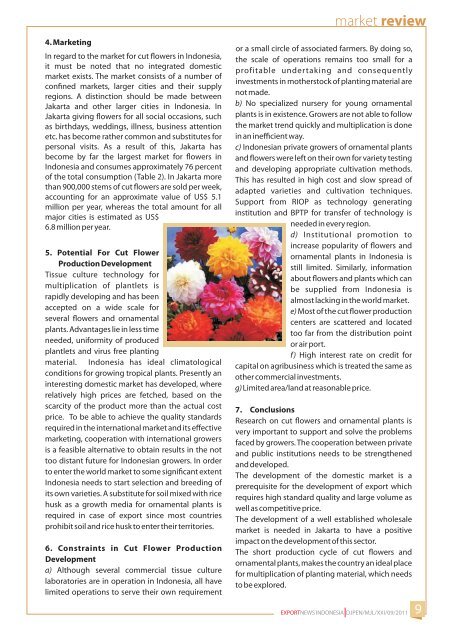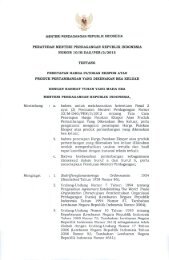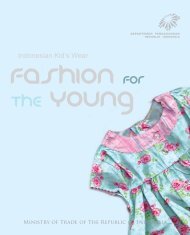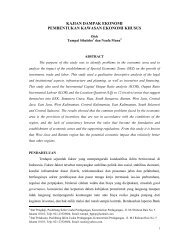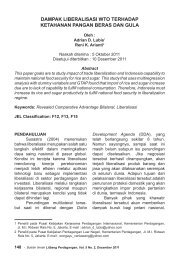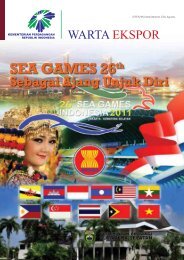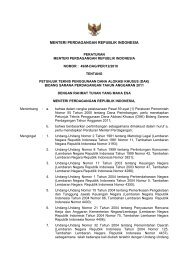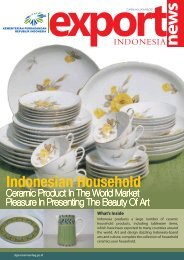Ornamental Plants - Directorate General for National Export ...
Ornamental Plants - Directorate General for National Export ...
Ornamental Plants - Directorate General for National Export ...
You also want an ePaper? Increase the reach of your titles
YUMPU automatically turns print PDFs into web optimized ePapers that Google loves.
market review<br />
4. Marketing<br />
In regard to the market <strong>for</strong> cut flowers in Indonesia,<br />
it must be noted that no integrated domestic<br />
market exists. The market consists of a number of<br />
confined markets, larger cities and their supply<br />
regions. A distinction should be made between<br />
Jakarta and other larger cities in Indonesia. In<br />
Jakarta giving flowers <strong>for</strong> all social occasions, such<br />
as birthdays, weddings, illness, business attention<br />
etc. has become rather common and substitutes <strong>for</strong><br />
personal visits. As a result of this, Jakarta has<br />
become by far the largest market <strong>for</strong> flowers in<br />
Indonesia and consumes approximately 76 percent<br />
of the total consumption (Table 2). In Jakarta more<br />
than 900,000 stems of cut flowers are sold per week,<br />
accounting <strong>for</strong> an approximate value of US$ 5.1<br />
million per year, whereas the total amount <strong>for</strong> all<br />
major cities is estimated as US$<br />
6.8 million per year.<br />
5. Potential For Cut Flower<br />
Production Development<br />
Tissue culture technology <strong>for</strong><br />
multiplication of plantlets is<br />
rapidly developing and has been<br />
accepted on a wide scale <strong>for</strong><br />
several flowers and ornamental<br />
plants. Advantages lie in less time<br />
needed, uni<strong>for</strong>mity of produced<br />
plantlets and virus free planting<br />
material. Indonesia has ideal climatological<br />
conditions <strong>for</strong> growing tropical plants. Presently an<br />
interesting domestic market has developed, where<br />
relatively high prices are fetched, based on the<br />
scarcity of the product more than the actual cost<br />
price. To be able to achieve the quality standards<br />
required in the international market and its effective<br />
marketing, cooperation with international growers<br />
is a feasible alternative to obtain results in the not<br />
too distant future <strong>for</strong> Indonesian growers. In order<br />
to enter the world market to some significant extent<br />
Indonesia needs to start selection and breeding of<br />
its own varieties. A substitute <strong>for</strong> soil mixed with rice<br />
husk as a growth media <strong>for</strong> ornamental plants is<br />
required in case of export since most countries<br />
prohibit soil and rice husk to enter their territories.<br />
6. Constraints in Cut Flower Production<br />
Development<br />
a) Although several commercial tissue culture<br />
laboratories are in operation in Indonesia, all have<br />
limited operations to serve their own requirement<br />
or a small circle of associated farmers. By doing so,<br />
the scale of operations remains too small <strong>for</strong> a<br />
profitable undertaking and consequently<br />
investments in motherstock of planting material are<br />
not made.<br />
b) No specialized nursery <strong>for</strong> young ornamental<br />
plants is in existence. Growers are not able to follow<br />
the market trend quickly and multiplication is done<br />
in an inefficient way.<br />
c) Indonesian private growers of ornamental plants<br />
and flowers were left on their own <strong>for</strong> variety testing<br />
and developing appropriate cultivation methods.<br />
This has resulted in high cost and slow spread of<br />
adapted varieties and cultivation techniques.<br />
Support from RIOP as technology generating<br />
institution and BPTP <strong>for</strong> transfer of technology is<br />
needed in every region.<br />
d) Institutional promotion to<br />
increase popularity of flowers and<br />
ornamental plants in Indonesia is<br />
still limited. Similarly, in<strong>for</strong>mation<br />
about flowers and plants which can<br />
be supplied from Indonesia is<br />
almost lacking in the world market.<br />
e) Most of the cut flower production<br />
centers are scattered and located<br />
too far from the distribution point<br />
or air port.<br />
f) High interest rate on credit <strong>for</strong><br />
capital on agribusiness which is treated the same as<br />
other commercial investments.<br />
g) Limited area/land at reasonable price.<br />
7. Conclusions<br />
Research on cut flowers and ornamental plants is<br />
very important to support and solve the problems<br />
faced by growers. The cooperation between private<br />
and public institutions needs to be strengthened<br />
and developed.<br />
The development of the domestic market is a<br />
prerequisite <strong>for</strong> the development of export which<br />
requires high standard quality and large volume as<br />
well as competitive price.<br />
The development of a well established wholesale<br />
market is needed in Jakarta to have a positive<br />
impact on the development of this sector.<br />
The short production cycle of cut flowers and<br />
ornamental plants, makes the country an ideal place<br />
<strong>for</strong> multiplication of planting material, which needs<br />
to be explored.<br />
EXPORTNEWS INDONESIA DJPEN/MJL/XXI/09/2011 9


